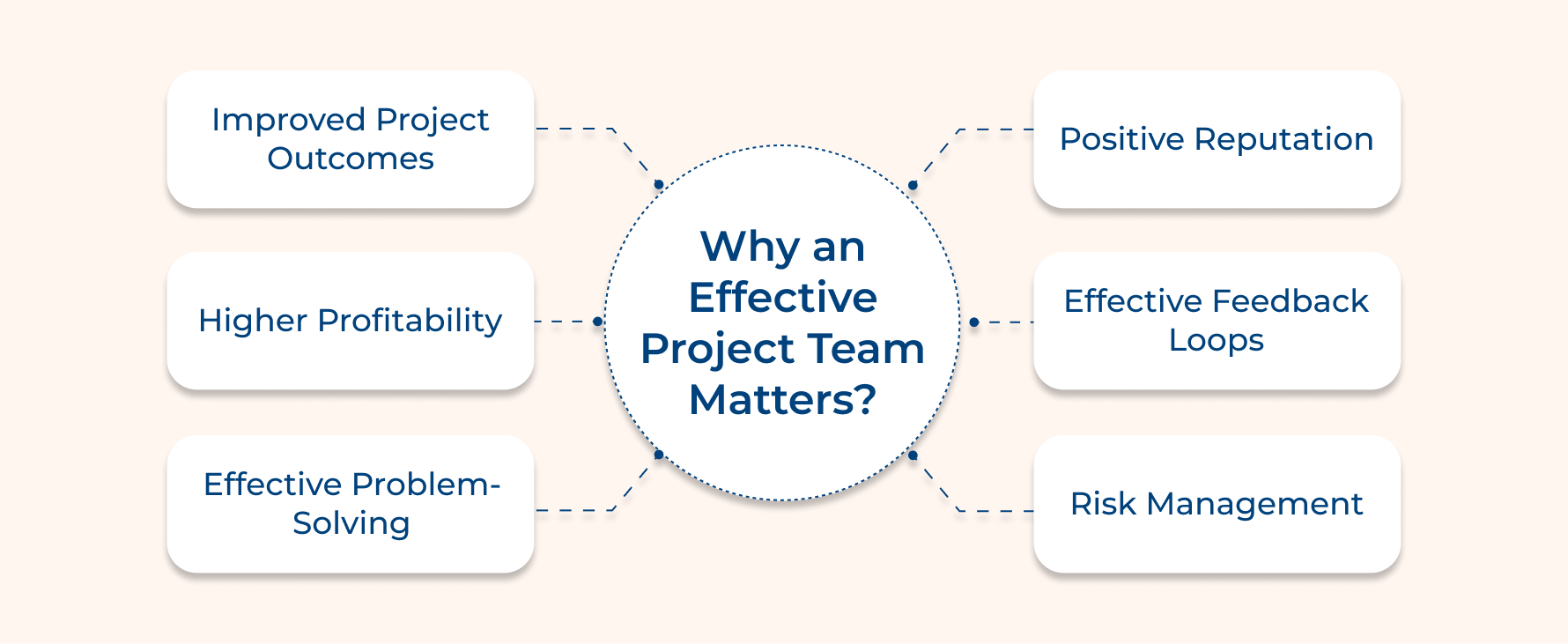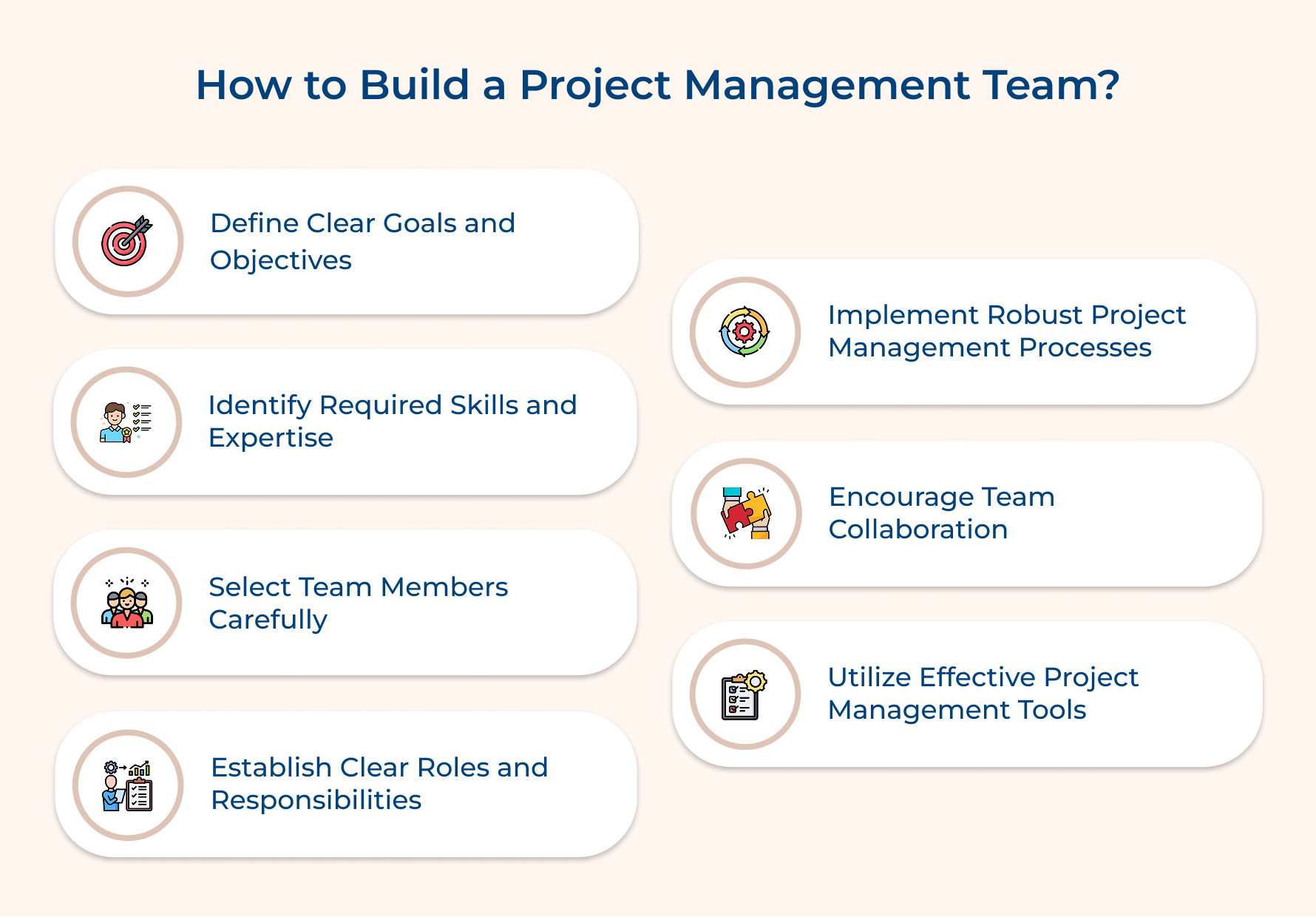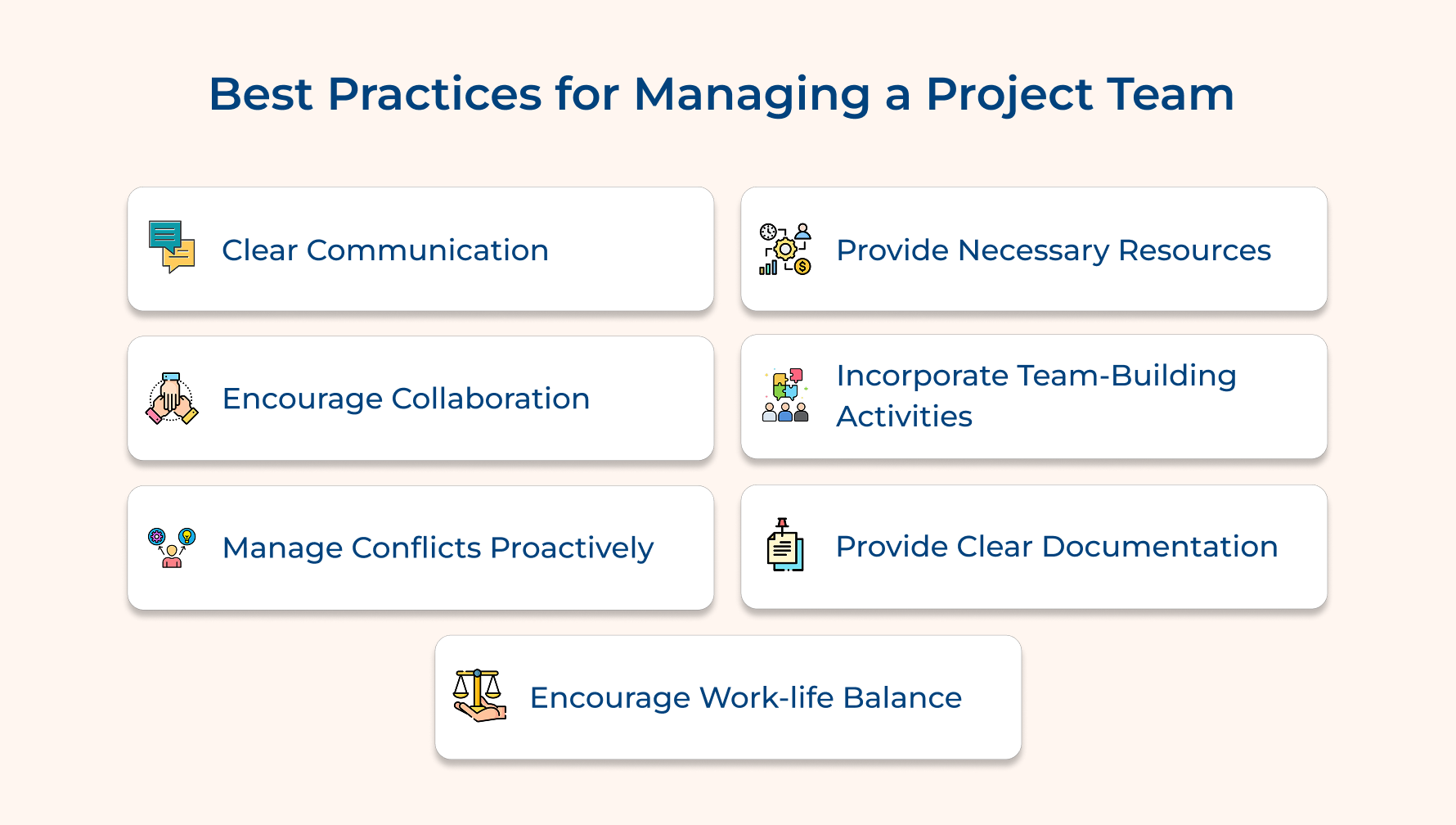How to Build a Project Team & its Best Practices

Key Highlights:
- Define SMART goals and assign clear roles to ensure team alignment as well as accountability.
- Build teamwork through open communication, regular meetings, and collaborative tools.
- Building a project team helps implement robust project management processes and tools to streamline workflows.
Have you ever faced missed deadlines, budget overruns, or unhappy clients because your team wasn’t quite in sync? You’re not alone.
Poorly structured teams can lead to communication breakdowns, skill mismatches, and a lack of unity. There’s little room for mistakes with competition heating up and client demands rising.
So, what’s the secret behind how to build a project team that delivers excellence every time?
We’ll dive into proven techniques to help you lead high-performing teams that not only meet but exceed client expectations. Let’s get started!
What is a Project Team?
A project team is a group of professionals brought together to achieve specific goals within a defined timeframe, often focused on delivering a unique product, service, or result. Cross-functional teams typically consist of individuals with diverse skills and expertise, tackling complex challenges collaboratively.
The structure of a project team can vary depending on the project’s scope and requirements, but effective teams are characterized by clear roles, open communication, along with a shared commitment to success.
Key objectives:
- Achieving project goals: The primary aim is to deliver the project within scope, time, and budget, ensuring all objectives are met.
- Building collaboration: Encouraging teamwork and communication among members promotes a positive environment where ideas can flourish.
- Enhancing client satisfaction: Delivering high-quality work and maintaining clear communication helps meet client expectations.
Why an Effective Project Team Matters?
An effective project team drives success and innovation. Understanding its importance can significantly impact project outcomes. Here are the key insights.
Improved project outcomes: Effective project teams consistently deliver high-quality results, meeting or exceeding client expectations. Team leaders ensure that members efficiently manage resources, adhere to timelines, and ensure deliverables align with project goals.
Higher profitability: Well-functioning teams optimize resource allocation, minimize costly errors, and complete projects more efficiently. Improved productivity and reduced waste directly contribute to increased profitability for the firm or agency.
Effective problem-solving: A strong project leader leverages diverse expertise to tackle complex challenges. Members collaborate to identify innovative solutions, adapt to changes quickly, and overcome obstacles that could otherwise derail project progress.
Positive reputation: Consistently successful project outcomes build a strong reputation for the firm. Enhanced client trust, increased referrals, and improved positioning as a reliable, high-quality service provider in the industry naturally follow.
Effective feedback loops: Cohesive teams build open communication for constructive feedback. Regular feedback between team members, leaders, and clients helps refine processes, address issues promptly, as well as enhance overall project performance.
Risk management: Effective project teams excel at identifying, assessing, and mitigating risks. Collective expertise as well as proactive approaches help anticipate potential issues, and develop contingency plans while minimizing the impact of unforeseen challenges.
How to Build a High-Performing Project Management Team?
Creating a high-performing project management team requires strategic planning and strong leadership. Let’s discover essential steps for success with these steps:
1. Define Clear Goals and Objectives
Imagine you’re launching a new marketing campaign. Without clear goals, one team member might focus on increasing website traffic, while another prioritizes social media engagement. The result? Confusion and scattered resources.
Now, let’s switch it up with a SMART goal:
“Increase website traffic by 20% within three months by running targeted ads.” It gives everyone clarity on what to aim for, how to measure success, and the timeline for achieving it.
Breaking it down further, you might set smaller milestones like “Finalize ad creatives by Week 1” or “Launch ads on platforms by Week 2.”
By involving the team in setting these goals, they feel a sense of ownership, making them more committed to hitting the targets.
2. Identify Required Skills and Expertise
To deliver a successful project, your team needs the right skills and expertise. Here’s how to make sure you’re covered:
Analyze Project Needs:
- Break the project into specific tasks.
- Identify the skills and expertise required for each task.
Create a Skills Matrix:
- Map out team members’ existing skills.
- Highlight any gaps between project needs and current capabilities.
Take Action on Skill Gaps:
- Recruit: Bring in new talent to fill critical gaps.
- Train: Upskill your current team with targeted training.
- Outsource: Partner with external experts if needed.
Reassess Regularly:
- Projects evolve, and so do skill requirements. Periodically review and update your skills matrix.
- Gather feedback from the team to uncover hidden gaps or future training opportunities.
3. Select Team Members Carefully
Building a strong project management team starts with careful selection. But how do you ensure you’re picking the right people for the job?
Start by considering the mix of skills, experience, and personalities needed to meet your project’s demands. A well-chosen team reduces conflicts, enhances collaboration, and boosts morale.
What’s your ideal team dynamic?
Think about the blend of technical expertise and soft skills your project needs. For instance, someone great at communication can bridge gaps between technical and non-technical team members.
Follow a Structured Selection Process:
- Assess skills: Use evaluations or tests to confirm technical abilities.
- Behavioral interviews: Ask questions like, “Tell me about a time you resolved a team conflict.”
- Trial projects: Assign short tasks to see how candidates work in real-world scenarios.
A variety of perspectives sparks creativity and innovation. Strive for diversity in skills, backgrounds, and ideas to create a well-rounded team.
4. Establish Clear Roles and Responsibilities
Assigning specific tasks to each team member not only ensures accountability but also boosts motivation. When people know their role, they can focus on their strengths and contribute effectively without stepping on anyone else’s toes.
Start with a detailed description of each role. Tools like a RACI matrix can help clarify who is responsible, accountable, consulted, and informed at different stages.
For instance, the social media manager may be responsible for posting, but the campaign strategist is consulted for approvals.
To keep things running smoothly, regularly revisit and update these roles. As the project evolves, responsibilities might shift, and that’s okay! Discuss changes openly in team meetings to ensure everyone stays aligned.
5. Implement Robust Project Management Processes
Robust project management processes guide your team, ensuring you hit your milestones on time and avoid unnecessary detours. Here’s what you can do to establish these processes effectively:
Standardize Your Processes
- Develop clear frameworks for core activities like planning, scheduling, risk management, and reporting.
- Ensure these processes are documented and accessible to everyone on the team.
Train Your Team
- Provide training sessions to help team members understand their role in the process.
- Teach them how to use project management software for seamless execution.
- After each project, ask your team what worked and what didn’t. Use feedback to fine-tune processes for future projects.
6. Encourage Team Collaboration
Team collaboration is key to driving creativity and improving problem-solving in any project. When team members work together, they share knowledge, reduce silos, and build stronger relationships, leading to more innovative solutions as well as faster decisions.
To boost collaboration, implement tools like Slack or Microsoft Teams to keep communication flowing seamlessly.
Regular team meetings, brainstorming sessions, and cross-functional projects offer opportunities to collaborate both formally as well as informally.
Encouraging open dialogue or active listening helps maintain a positive team culture, while recognizing and rewarding collaborative efforts reinforces its importance. This way, you can create an environment where everyone thrives together.
7. Utilize Effective Project Management Tools
Effective project management tools are essential for streamlining processes and improving overall project visibility. Make the most of it by:
Evaluating Your Team’s Needs
- Assess what features your team requires, like time tracking, reporting, or task management.
- Prioritize tools that align with your project management methodology.
Choose a Centralized Platform
- Implement a platform where tasks, progress tracking, and document sharing can be managed in one place.
- Ensure the platform supports collaboration and easy communication.
Specialized Tools for Specific Tasks
- Use dedicated tools for functions like resource management, risk assessment, or time tracking.
- Integrate these tools for a seamless workflow without data silos.
Monitor and Improve Usage
- Regularly review how tools are being used.
- Gather feedback from your team to identify any areas for improvement.
- By following these steps, you’ll enhance communication, decision-making, and resource management across your projects.
Best Practices for Managing a Project Team
Effective management practices are vital for team cohesion and project success. Learn how to implement these strategies effectively. Here are the recommendations.
Clear communication: Hold regular team meetings, use collaborative tools, and encourage transparent discussions. Ensure all team members understand project goals, timelines, and their individual responsibilities.
Encourage collaboration: Create opportunities for cross-functional cooperation, knowledge sharing, and idea exchange. Recognize and reward collaborative efforts to reinforce their importance within the team.
Manage conflicts proactively: Address disagreements or tensions early. Implement conflict resolution strategies, encourage open dialogue, and mediate disputes fairly.
Provide necessary resources: Equip your team with essential tools, software, and training. Ensure access to required information and subject matter experts.
Incorporate team-building activities: Organize team-building exercises to strengthen relationships and trust. Plan both work-related as well as social activities that promote camaraderie, improve communication, and enhance overall team cohesion.
Provide clear documentation: Maintain comprehensive project documentation, including goals, timelines, and responsibilities. Keep records of decisions, changes, and progress. Ensure easy access to this information for all team members.
Encourage work-life balance: Promote a healthy work environment by respecting personal time. Set realistic deadlines, discourage overwork, and support flexible working arrangements when possible. Prioritize team well-being to enhance long-term productivity and satisfaction.
Achieving Project Goals Through Well-structured Team
Building a successful project team is fundamental for achieving desired outcomes in professional services and agencies. A well-structured team builds collaboration, enhances communication, and aligns efforts toward common goals. Clear objectives and defined roles create a sense of ownership as well as accountability among team members.
Implementing effective project management practices further streamlines workflows and improves efficiency. Regular check-ins and the use of collaborative tools help maintain momentum as well as address challenges proactively. Investing in team development ensures members continuously enhance their skills, adapting to evolving project demands.
Ultimately, a high-performing project team not only drives project success but also strengthens client relationships, positioning your agency for long-term growth and sustainability.
Limit time — not creativity
Everything you need for customer support, marketing & sales.
Neeti Singh is a passionate content writer at Kooper, where he transforms complex concepts into clear, engaging and actionable content. With a keen eye for detail and a love for technology, Tushar Joshi crafts blog posts, guides and articles that help readers navigate the fast-evolving world of software solutions.


